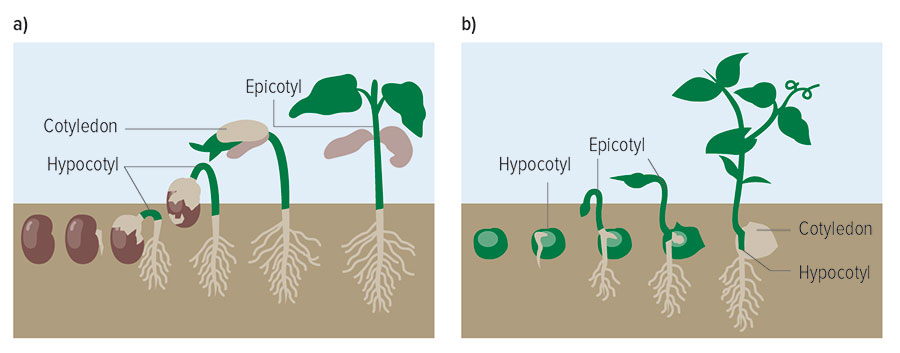Field work, combined with modelling historical climate data, is giving more certainty to a new sowing practice for high-value pulses.
As traditional sowing times and methods are challenged by changing climate in Western Australia, crop species and practices are being sought that could add flexibility to cropping programs. Certain high-value pulses are showing they may be able to play a role when sown deep and early.
Across the low and medium-rainfall zones (LRZ/MRZ) in the northern and eastern areas of the WA grainbelt, recent years have shown a significant increase in summer rainfall.
Summer rainfall and small autumn rainfall events can result in subsurface moisture – deeper than 50 millimetres – being available in the sowing window. This moisture could be adequate for germination and establishment, even when surface soils are dry. If moisture is present at depth, deep sowing into this moisture would allow growers to sow and get crops up prior to the season break, potentially offering yield benefits and allowing for more flexibility within their sowing programs.
With GRDC support, Dr Sarah Rich from CSIRO has been exploring this potential to ‘chase water’ by deep sowing.
“There is little understanding of how often and in what locations deep sowing will offer a benefit, so we have been teaming field work, glasshouse work and modelling scenarios on early and deep sowing to help boost grower confidence in these practices in the low and medium-rainfall zones of Western Australia,” Dr Rich says.
Dr Rich has been looking at the potential of using high-value pulses for early and deep sowing.
There has been renewed interest in high-value pulses with the release of Ascochyta-resistant and acid-tolerant varieties, as the returns are good and growers do not necessarily need to achieve high yields. It is a matter of assessing where they fit into their environmental conditions and cropping program.
Special pulse attributes
Certain pulse species have particular germination characteristics that enable them to germinate from depth.
For example, chickpeas, lentils, field peas and vetch have what is called ‘hypogeal emergence’, where the cotyledons remain underground and only the stem above them (epicotyl) lengthens to protrude from the soil. This compares with ‘epigeal emergence’ of lupins, where the hypocotyl expands to push the cotyledons and growing apex above the soil surface (Figure 1). This requires a lot more energy for the germinating lupin seed and precludes it being sown at depth.
Figure 1: Epigeal germination of lupins (left) as compared to hypogeal germination of chickpeas, lentils, field peas and vetch, which enable the latter to be sown at greater depth to chase moisture.

From: https://www.plantscience4u.com/2014/08/types-of-seed-germination-epigeal-and.html
“Our field work has established that chickpea and lentil crops can be successfully grown on sands outside the traditional growing areas for these crops in Western Australia,” Dr Rich says.
Our preliminary trials show chickpeas, lentils, field peas and vetch can be sown in the field to depths of up to 150mm, with little delay to emergence and no significant impact on establishment.
“Further, in the glasshouse, we have found there is little genetic variation in emergence ability and epicotyl elongation rate across common commercial varieties of chickpeas and lentils.
“Additionally, seed size does not impact on emergence rate from deep sowing. However, very small seeds will allocate seed resources differently to large seeds, resulting in a lower-vigour seedling at emergence.”
Modelling scenarios
To gain an understanding of how often and where an opportunity occurs where deep sowing would be beneficial, Dr Rich modelled scenarios using the Agricultural Production Systems sIMulator (APSIM).
Figure 2 shows the daily probability of a sowing opportunity depending on depth of sowing undertaken as generated by APSIM over the past 50 years (1971–2020). Sowing opportunity was defined as availability of enough soil water for seed to germinate for at least six days in a row in the soil of that depth.
Figure 2. Daily probability of sowing opportunity for low and medium-rainfall locations, depending on depth of sowing undertaken, modelled by APSIM over the past 50 years.

Source: CSIRO
For the 20 to 100mm (medium blue) and 20 to 200mm (light blue) sowings, opportunity was calculated as opportunistic sowing to any 50mm soil layer, down to that depth where there was adequate moisture for six days’ moisture, even if standard 20 to 50mm (dark blue) sowing depths were dry.
“The APSIM modelling showed that depending on soil type and location, deep sowing opportunities may be present even when surface layers are dry. Across the LRZ and MRZ of Western Australia, increasing sowing depths by even a small amount into the 50 to 100mm layer can significantly increase sowing opportunities,” Dr Rich says.
In drier regions across the LRZ, where large rainfall events can be sporadic even late in the sowing window, the increased sowing opportunity offered by deep sowing continues throughout the autumn.
“Our results give confidence that deep sowing could significantly increase sowing opportunity for crops that can be sown deeper than 50mm, like the high-value pulses (chickpeas and lentils) across the LRZ and MRZ of Western Australia.”
More information: Dr Sarah Rich, 0432 891 197, sarah.rich@csiro.au

























































